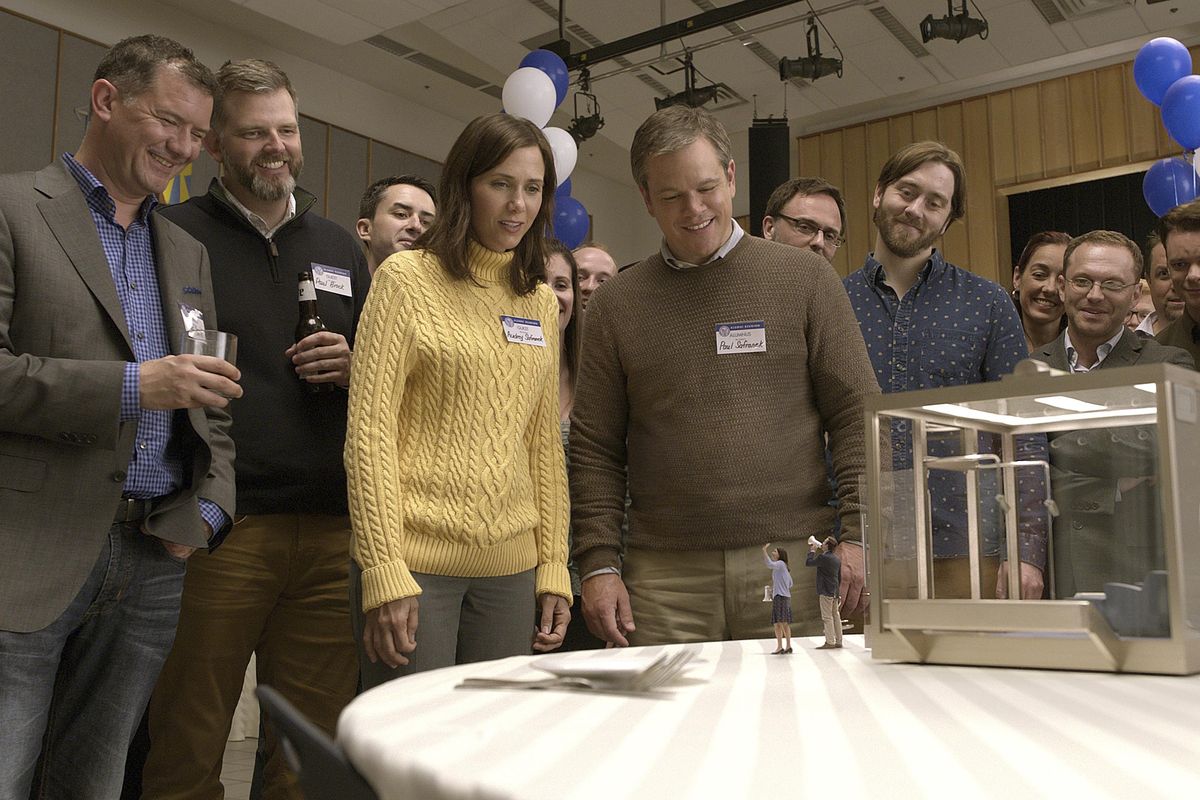Review: In ‘Downsizing,’ a parable for the anxieties of our age, in miniature

You know how Hollywood doesn’t make original movies anymore? Well, “Downsizing” is here to fix that. Weird and wonderful, zigging where it should zag and zagging where it should zig, this wildly imaginative flight of fancy strikes an admirably poised balance between whimsy, screwball comedy, social satire and generous meditation on the foibles and highest aspirations of human nature.
Those contradictory, sometimes confounding tones are ably juggled by Matt Damon, who assumes his most unassuming dad-bod accessibility to play Paul Safranek, a mild-mannered occupational therapist who works at Omaha Steaks in Nebraska. “Downsizing” takes place in an indeterminate future, 10 years after researchers in Scandinavia have discovered a method of “cellular reduction” that can safely shrink human beings to the size of Barbie dolls, thereby dramatically staving off their ruinous impact on the globe’s vanishing resources.
As the film opens, not everyone has “gone small.” But Paul, whose dutiful sense of helpfulness at work extends to his marriage to Audrey (Kristen Wiig), is intrigued. When friends show up at a party extolling the virtues of tiny living, the couple embarks on a tour of an all-small development called Leisure Land, where even modest means can bankroll a lifestyle of McMansion-esque luxury and manicured safety. In Leisure Land, a little goes a long way – literally, and figuratively.
Directed by Alexander Payne from a script he wrote with Jim Taylor, “Downsizing” isn’t played for broad, “Honey, I Shrunk Matt Damon” laughs. As is the case with so many of Payne’s films, the comedy here is mostly observational, with gentle sight gags and inventive camera work and stagecraft drawing viewers almost immediately into an alternate but entirely believable world.
Supported by an ingeniously banal production design by Stefania Cella, Payne and his team never make their miniaturized aesthetic over-cute, or an obvious punchline (although there’s a perfectly adorable moment when recently shrunk patients are gently transferred from gigantic gurneys to their now appropriately doll-sized beds). Instead, they create a world whose contours and dimensions feel at once alien and familiar, up to and including the geographic boundaries of Leisure Land that suggest it may not be the Edenic utopia its diminutive residents might think.
Tasked with leading viewers through what becomes an increasingly bizarre and labyrinthine adventure, Damon’s Everyman is a capable, if sometimes bemused guide, bringing his best self to bear when he falls in with a sybaritic neighbor named Dusan (Christoph Waltz), a South Asian domestic worker named Tran (Hong Chau) and, eventually, a polyglot cast of characters who embody a human race that’s just as chaotic, pluralistic, tragic and inspiring at five inches tall as it is at five feet. There is cynicism on view in “Downsizing”: Along with such fellow directors as Darren Aronofsky and Guillermo del Toro, Payne is clearly distressed at the social, political and environmental degradation he sees around him. But rather than succumbing to despair, he chooses to honor the struggle between our worst and best selves.
“Downsizing” touches knowingly on such present-day issues as climate change, immigration, widening wealth disparity and terrorism. But its deepest philosophical issues, and their most confrontational crux, play out in Paul’s evolving relationship with Tran, portrayed by Chau in a performance that is spiky, endearing, bracingly direct and touchingly expressive.
As the story makes its circuitous way through its surprising dog legs, what viewers suspect is going to be a patronizing fable of acceptance and tolerance instead becomes much tougher and more honest, with Paul’s interior journey taking on an almost spiritual dimension of self-reckoning. You never quite know where “Downsizing” is going, and that is by design: Payne is unafraid to cultivate destabilization in his audience that some members will find off-putting, others liberating.
The rewards are rich and revelatory in a film that doesn’t soft-pedal the woes facing the planet, but celebrates the kind of direct, healing action that makes it worth fighting for, even in the face of certain doom.